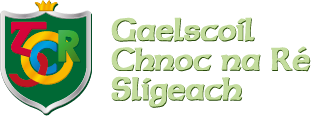| Cad is Tuimoideachas ann?Ciallaíonn an tumoideachas córas ina múintear gach ábhar trí theanga shonraithe amháin. I gcás na ngaelscoileanna is í an Ghaeilge teanga thumtha an chórais. Is í an Ghaeilge meán cumarsáide agus teagasc na scoile. Is í an Ghaeilge agus teanga oibre na scoile. Leanann páistí i ngaelscoileanna an gnáth churaclaim scoile mar atá leagtha síos ag an Roinn Oideachas agus Eolaíochta ó dheas nó an Roinn Oideachais ó thuaidh. Baintear amach líofacht iomlán sa Bhéarla agus sa Ghaeilge tríd an chóras seo. Tá múnlaí éagsúla den tumoideachas á gcleachtadh go hidirnáisiúnta. Faoi láthair tá múnlaí chomhchosúla den tumoideachas á gcleachtadh sna gaelscoileanna, bunaithe ar an dea-chleachtas idirnáisiúnta. | What is Immersion Education? In the immersion education model pupils learn all subjects through the medium of a designated language. In Irish-medium schools or gaelscoileanna, Irish is the language through which all subjects are taught and all communication is conducted. Irish becomes the working language of the school. Pupils attending a gaelscoil follow the standard curriculum as laid out by the Department of Education and Science in the south or the Department of Education in the north. Through the immersion system pupils achieve a high level of fluency in both English and Irish. Various models of immersion education are practiced internationally. Similar models, based on international best-practice are practiced in gaelscoileanna. |
| Cén fáth go roghnóinn an tumoideachas do mo pháiste?* Baintear amach ard-chaighdeán oideachais i ngach ábhar an churaclaim, sa Bhéarla ach go háirithe.
* Tá sé cruthaithe gurb é an córas is éifeachtaí do shealbhú na Gaeilge. |
Why should I choose immersion education for my child? * It provides high quality education in all subject areas, particularly in English.
* It is proven to be the most effective way of learning the Irish language. |
| Cén ról atá ann domsa mar thuismitheoir?Tá go leor bealaí gur féidir leat cabhrú mar thuismitheoir, ina measc:-
* Mura bhfuil gaelscoil i do cheantar agus dá mba mhian leat go mbeadh an deis seo ar fáil do do pháiste, déan teagmháil le Gaelscoileanna Teo., nó le Comhairle na Gaelscolaíochta ó thuaidh. * Glac ról gníomhach i scolaíocht iomlán do pháiste. Is féidir moltaí a fháil faoi seo ó Choiste na dTuismitheoirí agus ó fhoireann na scoile. * Tá sé an-tábhachtach spéis a léiriú in obair bhaile do pháiste chomh maith le léitheoireacht sa dá theanga, Béarla agus Gaeilge a spreagadh. |
What role do I play as a parent? There are many ways in which parents can help, including:-
* If there is no gaelscoil in your area and you would like your child to have the option of attending an Irish-medium school, contact Gaelscoileanna Teo. or Comhairle na Gaelscolaíochta in the north. * Play an active part in your child’s schooling. Advice is available from the school’s Parents’ Council and staff. * It is vital to show an interest in your child’s homework as well as encouraging reading in both English and Irish. |
| An gá go mbeadh Gaeilge agam mar thuismitheoir?* Ní ghá go mbeadh ach is buntáiste é don pháiste má tá Gaeilge á labhairt sa bhaile agus gur léir don pháiste nach teanga scoile amháin í an Ghaeilge.
* Fáiltítear go mór roimh pháistí ó gach cúlra teanga agus cultúir. * Cuirtear tacaíocht teanga ar fáil do thuismitheoirí a dteastaíonn uathu a scileanna Gaeilge a fheabhsú. * Cabhraíonn meon dearfach le forbairt an pháiste agus tá sé seo amhlaidh d’fhorbairt iomlán an pháiste sa ghaelscoil. |
Is it necessary for me as a parent to speak Irish? * While it is not necessary for you to be able to speak Irish, it is an advantage to your child if Irish is spoken in the home, as they can see that it is not just a school language.
* Children from all linguistic and cultural backgrounds are welcome in the gaelscoileanna. * Irish-language support is provided as much as possible to parents who wish to improve their skills. * A positive mental attitude is fundamental to your child’s development, as it is for children in gaelscoileanna. |
| Buntáistí an Oideachais Dátheangaigh Cuimsítear i measc na mbuntáistí atá aitheanta sa taighde idirnáisiúnta:-
BUNTÁISTÍ AN CHURACLAIM 1. Gnóthachtáil mhéadaithe curaclaim. 2. Níos éasca an 3ú agus an 4ú teanga a shealbhú. BUNTÁISTÍ CUMARSÁIDE 3. An Dátheangachas (cumas dhá theanga a labhairt go líofa). 4. Litearthacht i dhá theanga (léamh agus scríobh i dhá theanga). 5. Cumarsáid níos forleithne (teaghlach, pobal, cairde, fostaíocht). BUNTÁISTÍ CULTÚRTHA 6. Inchultúrú níos forleithne (ag foghlaim agus ag glacadh fút féin luachanna cultúir eile); ilchultúrachas níos doimhne; Caoinfhulaingt cultúir eile níos fearr. BUNTÁISTÍ COGNAÍOCHA 7. Buntáistí smaointeoireachta (cruthaitheacht, íogaireacht cumarsáide). BUNTÁISTÍ CARACHTAIR 8. Féinmhuinín níos airde. 9. Diongbháilteacht féiniúlachta. BUNTÁISTÍ AIRGID 10. Buntáistí eacnamaíochta agus fostaíochta. (Oiriúnaithe ag GAELSCOILEANNA TEO. ó Baker, 2003) |
Advantages of Immersion Education Some of the documented advantages of immersion education include:-
CURRICULUM ADVANTAGES 1. Greater academic success. 2. Easier to learn a third and fourth language. COMMUNICATIVE ADVANTAGES 3 Bilingualism (the ability to speak two languages fluently). 4. Biliteracy (the ability to read and write in two languages). 5. Wider communication (extended family,community, friends, employment). CULTURAL ADVANTAGES 6. Broader exposure to and appreciation of the value of various cultures (enculturation), deeper multi-culturalism, greater tolerance and less racism. COGNITIVE ADVANTAGES 7. Thinking benefits (creativity, sensitivity to communication). CHARACTER ADVANTAGES 8. Raised self-esteem. 9. Security in identity. FINANCIAL ADVANTAGES 10. Economic and employment benefits. (adapted by GAELSCOILEANNA TEO. from Baker, 2003) |
Baile Uí Dhúgáin, Sligeach
Fón: (071) 917 4019
Fón: (071) 917 4019

 Gaelscoil Chnoc na Ré, Sligeach Sligo's Irish Medium Primary School
Gaelscoil Chnoc na Ré, Sligeach Sligo's Irish Medium Primary School
2 comments
Pingback: Clárúcháin/Enrolment 2017 | Gaelscoil Chnoc na Ré, Sligeach
Pingback: Clárúcháin / Enrolment 2021 | Gaelscoil Chnoc na Ré, Sligeach